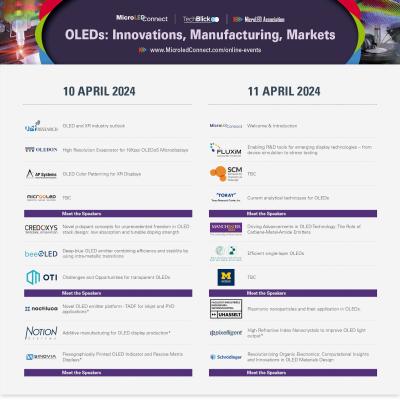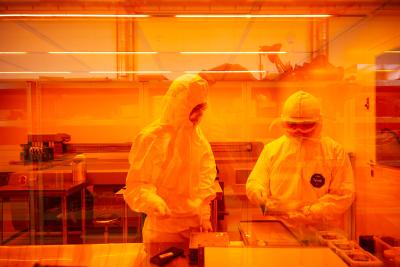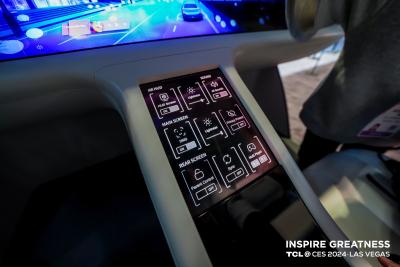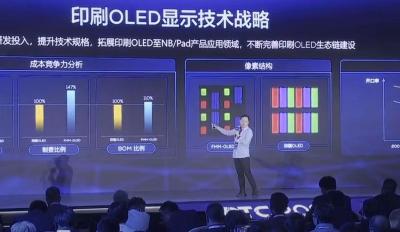OLED (Organic Light Emitting Diodes) is a flat light emitting technology, made by placing a series of organic thin films (usually carbon based) between two conductors. When an electrical current is applied, light is emitted. OLEDs are used to make displays and lighting panels. OLEDs today are widely used in TVs, smartphones, tablets, laptops and wearables.
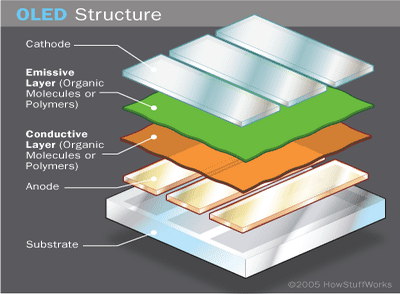
While OLED displays excel in color-contrast and efficiency compared to LCDs, they’ve also proven relatively hard to produce on a large scale. A potential technology that could reduce OLED production costs is inkjet printing.
OLED inkjet printing
Current OLED production relies on evaporation processes, in which the organic materials are deposited onto a glass sheet through a thin metal stencil, also known as a "shadow mask". This process is problematic, as a significant amount of the material is wasted because it disperses all over the mask, in addition to inherent mask changes which expose the sheet to dust and compromise yields (OLEDs are by nature sensitive to contamination).
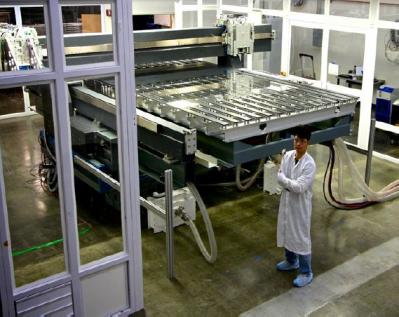
Inkjet OLED printing has the desirable ability to allow precision deposition without the use of a mask. It also produces less stray particles, thus boosting yields. These significant advantages make this technology interesting to many OLED developers. Printing OLEDs, though, is a challenging task - in terms of production process viability, drying the materials, production time, and the soluble OLED materials which are less effective than evaporable ones. It is also challenging for inkjet printing to reach high densities, and in the past it was believed that inkjet printing is only suitable for TV production. In recent years, though there's been much improvement and now we are seeing higher density prototypes (laptop displays, for example).
Printed OLEDs in 2024
Inkjet printing is adopted in OLED production today in two areas. One is the encapsulation layer deposition - almost all OLEDs that adopt TFE encapsulation use inkjet printing to deposit the organic elements. Inkjet printing is also used to deposit the quantum dots in Samsung's QD-OLED production process.
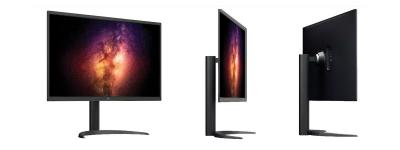
LG 32EP950 OLED monitor (31" 4K printed OLED panel by JOLED)
The most interesting use case for inkjet printing, though, is in the deposition of the OLED stack materials (emitters and other layers). The only company that attempted mass production using inkjet is Japan's JOLED, that in 2021 started printing OLED display panels in its 5.5-Gen production line in Nomi, Ishikawa Prefecture, Japan. The company did not manage to bring costs down and it filed for bankruptcy in 2023.
In 2024, China-based display maker TCL CSoT aims to initiate commercial inkjet printing OLED production in its low-volume 5.5-Gen line, targeting IT applications (laptops, monitors and tablets). The company demonstrated impressive prototypes over the last years, see video above.
Inkjet printing can also be used to deposit OLED materials for OLED lighting panels, which is an easier task compared to display production. In March 2024 Germany-based OLED lighting developer Inuru inaugurated its new OLED lighting inkjet printing production line, the "Dragon Factory", in Wildau near Berlin, Germany.
TCL CSOT shows its latest OLED, MicroLED and QD-EL displays at Displayweek 2024
TCL CSOT demonstrated its latest displays, technologies and prototypes at Display Week 2024. The company is focused on inkjet printing technologies, and a lot of the displays on show were indeed printed.
So first up, we TCL demonstrated a 14" 2880x1800 400 nits 30-120Hz ink-jet printed LTPO AMOLED display. The display is produced on a glass substrate, with thin film encapsulation (a 'hybrid OLED').
Samsung shows its latest OLED and QD-EL displays at Displayweek 2024
Samsung Display had a rather large booth at Displayweek 2024, showing its latest OLED displays and technologies. Samsung showed several displays - including foldable smartphone panels, laptop and tablet displays, two QD-OLED displays, its 9.4" round automotive AMOLED, and more.
One interesting display was a panel that combines a foldable and a rollable display, that can open up to an impressively large display. Samsung brands it as a Flex Note Extendable Display.
EHD live printing at Lopec 2024 - Small drops make the difference
Notion Systems and Scrona presented the n.jet EHD system to the public for the first time during the LOPEC 2024 exhibition. The globally unique multi nozzle EHD printing system for functional materials is capable of printing resolutions of < 1 µm or materials with viscosities of up to 10.000 cP.
Today the GEN3 EHD print head offers 8 fully digital nozzles with a pitch of 100µm which will be increased to 256 fully digital nozzles by Q1/2025, outperforming conventional inkjet printing by several orders of magnitude, paving the way for additive printing in applications dominated by photolithographic process.
The company reports a great interest in its booth and demonstration. Most visitors were not aware of the EHD technology and were very impressed by the technology and its capabilities.
Join us next week for a 2-day OLED innovations virtual event, as part of MicroLED-Connect!
MicroLED Connect, our hybrid event series focusing on the microLED industry, will be hosting a two-day virtual event focused on the OLED innovations, technologies, manufacturing, markets and more. The online event will take place next week, on April 10-11, and will be an excellent opportunity to learn the latest OLED updates and connect with industry professionals on our excellent online event platform.
Today we have published the agenda for this event, with 20 exciting talks by leading OLED developers, supply chain companies and top-edge researchers. This will be an excellent opportunity to learn and connect with the OLED industry. You can register for the event here, with a yearly pass to MicroLED-Connect (with an option to also include entry into our September on-site event in Eindhoven, The Netherlands). Our members also gain access to past event recordings.
Inuru inaugurates its inkjet printing OLED lighting production line in Wildau
Germany-based OLED lighting developer Inuru inaugurated its new OLED lighting panel production line, the "Dragon Factory", in Wildau near Berlin, Germany. This is an important milestone for Inuru, which is focusing on medication packaging and entertainment applications. The production line is now ready, but it will probably take some time to ramp-up and achieve full-scale production.
Inuru produces its OLED lighting panels using an inkjet printing process, which it says educes production costs by around 90% compared to conventional (evaporation-based) processes.
TCL CSoT showcases transparent, flexible and inkjet printed OLED displays at CES 2024
TCL CSoT demonstrated several OLED displays at CES 2024. first up we have an automotive 10.1” transparent OLED display, that offers 52% transparency. CSoT says that this is a "Smart Transparent" display, although it's not clear what is meant by that exactly.
The second display is a 14" 2.8K (2880x1800, 240 PPI) inkjet printed hybrid OLED. This is the first time that CSoT has printed a laptop AMOLED display. It uses an IGZO (Oxide-TFT) backplane, and offer a variable refresh rate (30-120Hz) to expand the battery life. This display was first shown last month, when TCL stated it is on track to start mass producing OLEDs using an inkjet printing process in the second half of 2024.
IPValue buys 200 OLED patents from Seiko Epson
IPValue Management announced that it has acquired around 200 OLED patents from Seiko Epson. We do not know the nature of these patents, and whether IPValue bought all of Seiko Epson's OLED IP portfolio or just a part of it. IPValue says that the patents will be owned by its subsidiary Lumitek Display Technology.
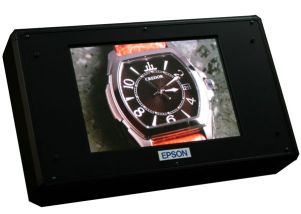
Seiko Epson has been working on OLED technologies for many years - and it has been involved mostly with soluble OLED materials, ink-jet printing and OLED microdisplays. In 2013 Samsung Display bought several OLED patents from Seiko Epson.
TCL CSoT reiterates plans to start producing inkjet printing OLEDs in 2024, to target IT displays
TCL CSoT says that it will start producing OLED displays using an inkjet printing process in the second half of 2024. This is excellent news and good to know CSoT is still on track for initial production in 2024. The company says it will first target the IT and medical sector.
The company says that the cost of producing OLEDs using its inkjet printed panels will be lower compared to the currently-used FMM based method, and its OLEDs will offer superior performance (in lifetime, mostly) as its process enables higher aperture.
Reports suggest Kateeva's printers failed Samsung's QD printing tests, will not be used for QD-OLED production
According to reports, Kateeva's QD-OLED printing project saga is not over. Samsung Display tested the company's latest printers, but these failed the tests and Samsung Display will not but these printers. SDC planned to replace the currently-used Semes' printers, which also suffer from low performance.
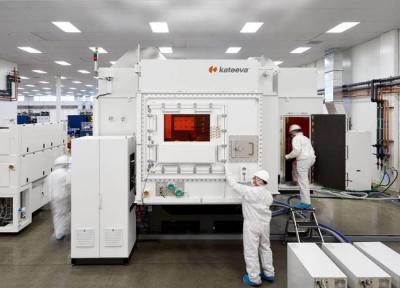
Samsung Display is also not committed yet to expand its QD-OLED production lines, which means that in any case it does not need to buy new printers for production expansion. Earlier reports suggested that SDC wanted to upgrade it current capability for higher density (to reach 8K TV printing), so this may be the reason behind the testing of Kateeva's new printers.
A senior researcher formerly working at Samsung Display, accused of stealing OLED trade secrets with an aim to sell them to Chinese display makers, returns to Korea to face chargers
In 2021, we reported that two researchers working at Samsung Display were convicted of handing over OLED technology to other companies, and are being sent to prison for two years. Representative and directors of the company that bought the technology was also sent to prison and the company was fined. The technology in question relates to Optical Adhesive Materials used in OLED production processes. The arrest of these employees was reported earlier in 2020.
It is now reported that another employee of Samsung Display, also involved in that case (seems to be he was the main organizer of the outfit) fled Korea following his indictment, but has now returned voluntarily to Korea and has been arrested and is now bring charged with violating unfair competition laws in Korea.
Pagination
- Page 1
- Next page

